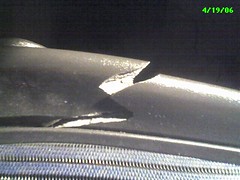My expertise in geekythings is limited to what I can do in the software of a system. Given a fully built linux box, I can run just about any program, write anything, do what I want with it. Bend it to my will as my whim directs.
But once outside that box, interfacing with the real world, my skills fall off. Some of my more geekier ambitions fall into interfacing with the computer and systems in ways other than just a keyboard, mouse and screen. Secondary controllers, mobile electronics, small devices that do ‘something’ for you and communicate amongst themselves. Fascinating, but really beyond my base knowledge.
So when I come across absolutely stunning projects like this one, it makes me keenly aware of the holes in my education. Embedded systems are a fascinating field, but one I don’t have the time to explore. Doesn’t mean I can’t appreciate things like this though:
The CLIVE Project is a combination hardware/software/art project that is on display at Burning Man The setting is an archway sculpture in the middle of the playa, with a large countdown clock on it, as well as a green laser shining up into the sky :
A giant digital clock that hangs from that arch counts down from 00:01:30. The warning spinners go still, having gotten your attention. The beam, still pointing oddly at nothing as the countdown marches on, slowly dims. As the clock reaches the last fifteen seconds a tiny dot in the sky gets just bright enough to be seen… moving swiftly towards the green pencil of light.
The dot is barely visible at first; in only seconds it’s brighter than the stars near it and then gets brighter yet. As it crosses the beam its light peaks — shimmering a good eight times brighter than anything else in the sky. It’s moving fast. Not so fast as a falling star, but quicker than most anything else one would see in the natural night sky.
Just as quickly it pases, fading; the laser dimmed to nothing, the entire archway gone dormant. No light; no sound… just that same travelling pinpoint of light dipping out of sight into blackness again. A few long seconds pass; maybe a halfminute or so. With a gentle whirr and flicker of green light the archway returns to life, counter resetting. “NEXT FLARE:” scrolls up on the display across the archway’s main beam, the 10-foot-long clock resetting and starting the countdown anew.
You just witnessed the magnitude -8 flare of an Iridium satellite, reflecting the sun straight at you as it passes overhead.
The large copper structure you’re standing under? It’s an almagest of sorts; a guide to the stars. We like to call it CLIVE: the Celestial Laser Identification / Visualization Experiment.
How cool is that?

 I think it’s a sign of the apocalypse. In the space of about 15 minutes, I not only smoked a video board (no, didn’t toke it up… it literally started smouldering while installed in the machine. The fan bearing had failed on the cooler), not only crashed said XP box right in the middle of getting information i was looking for, but in a fit of excitement, I apparently broke the seat of my nice Size C Aeron chair.
I think it’s a sign of the apocalypse. In the space of about 15 minutes, I not only smoked a video board (no, didn’t toke it up… it literally started smouldering while installed in the machine. The fan bearing had failed on the cooler), not only crashed said XP box right in the middle of getting information i was looking for, but in a fit of excitement, I apparently broke the seat of my nice Size C Aeron chair. I’ve been using ebay forever. And I mean, forever. DId you know that eBay wasn’t the original name of the project? It was called ‘Auctionweb’, and eBay was just the hosting company.
I’ve been using ebay forever. And I mean, forever. DId you know that eBay wasn’t the original name of the project? It was called ‘Auctionweb’, and eBay was just the hosting company. Well, I think this means I’ve finally gone overboard. Ever since I’ve been playing ‘seriously’ with
Well, I think this means I’ve finally gone overboard. Ever since I’ve been playing ‘seriously’ with 
